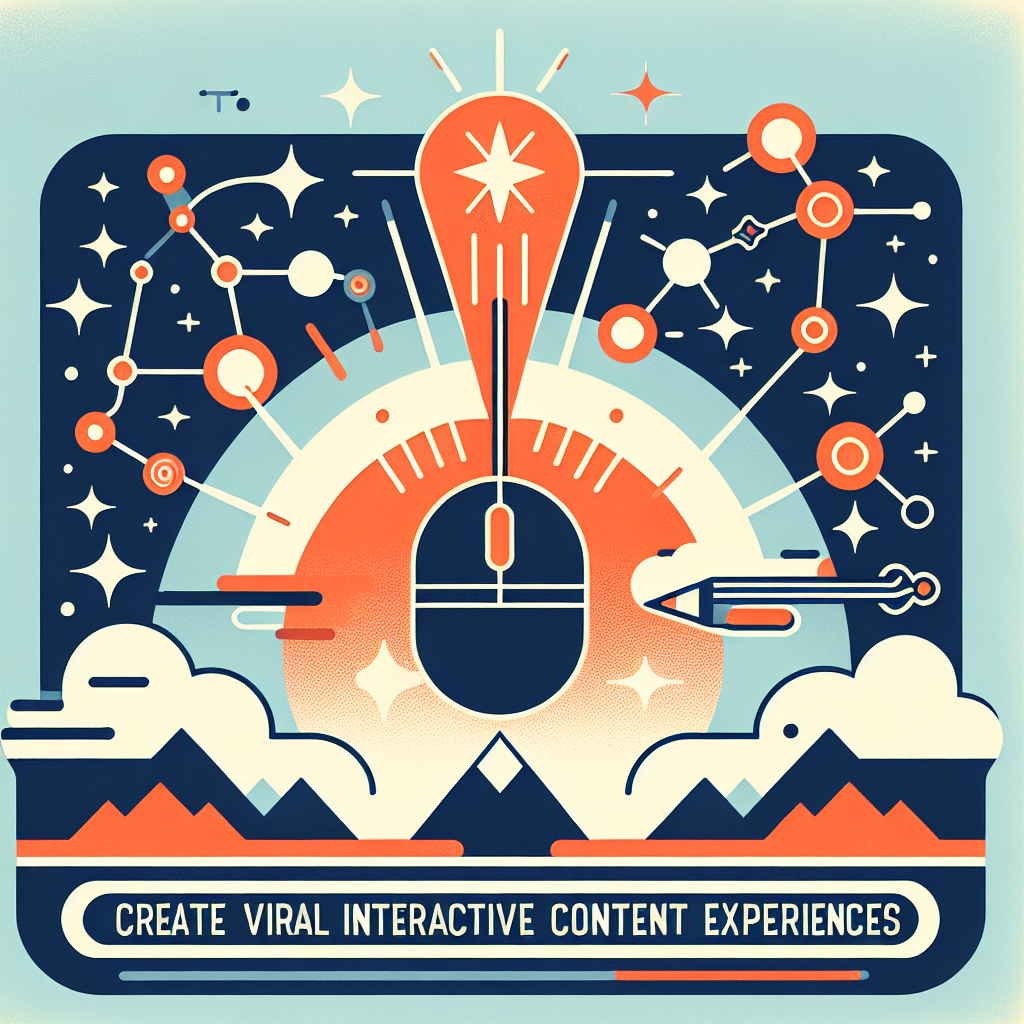An Introduction to Interactive Content in Digital Marketing
Ever wondered how to keep your audience engaged with your content longer? Or, how to turn passive consumers into active participants? The answer lies in using interactive content. As part of the vast and evolving digital marketing world, interactive content offers a fresh and dynamic way to communicate with audiences.
In this article, we’ll explore the ins and outs of interactive content. We’ll start by defining what it is and why it’s gaining traction. Then, we’ll look at the various types of interactive content one can use. We’ll also discuss the many benefits it can bring to your digital marketing strategies and show you successful examples that highlight its effectiveness.
Going deeper, we’ll explain how to integrate such content into your digital marketing strategy. And, we’ll examine the role of interactive content creators—the new-age professionals who are masters of creating engaging digital experiences. Additionally, we’ll highlight some great interactive content ideas and discuss what the future holds for this exciting area of digital marketing.
So, are you ready to give your digital marketing a thrilling twist? Let’s begin exploring!
Exploring Interactive Content in Digital Marketing
Defining Interactive Content
Interactive content is a type of digital material that engages users to participate actively rather than passively consuming information. Typical examples include quizzes, polls, interactive videos, and infographics.
Unlike static content, interactive formats encourage real-time engagement, increasing dwell time and user satisfaction.
Types of Interactive Content
A variety of interactive content formats exist, each providing a unique means of engagement. Here are a few popular types:
- Quizzes and Polls: These allow users to test their knowledge or provide opinions, often promoting sharing and discussion.
- Interactive Infographics: Visual content that requires user interaction to reveal more information or insights.
- Calculators: Tools that offer personalized calculations based on user input, often used in finance or health-related content.
- Interactive Videos: Videos that embed clickable areas, enabling users to choose different paths or explore more details.
Benefits of Interactive Content
Interactive content offers numerous advantages, making it an effective tool in digital marketing strategies. Key benefits include:
- Increased Engagement: By actively involving users, interactive content boosts engagement rates and decreases bounce rates.
- Data Collection: Interactive content can gather valuable user data and insights without being intrusive.
- Improved User Experience: Engaging and fun experiences keep users on your site longer and encourage return visits.
- Social Shares: Engaging content is more likely to be shared on social media, expanding your reach.
Examples of Successful Interactive Content
Many brands have effectively used interactive content to capture audience attention. Forbes offers a detailed explanation on how certain brands use this tool effectively in their campaigns.
Integrating Interactive Content into Your Strategy
Consider these practical steps to incorporate interactive content into your digital marketing strategy:
- Identify Goals: Determine what you want to achieve, whether it’s increased engagement, data collection, or brand awareness.
- Choose the Right Format: Select a format that aligns with your audience’s interests and your brand’s message.
- Promote Across Channels: Share your interactive content through various channels like social media and email to reach a broader audience.
- Analyze Performance: Use analytics tools to evaluate the performance and effectiveness of your interactive content, making adjustments as needed.
Developing a Framework for Interactive Content Creation
Mastering Interactive Content Strategy
Strategically planning your interactive content positions you for optimal user engagement. Design a plan by considering your target audience, setting clear objectives, and staying consistent with your brand’s narrative. By doing so, you can tailor your interactive content to user preferences and interests, thereby maximizing its impact.
Content Ideation and Creation
After formulating a strategy, your next step involves generating content ideas and turning them into interactive presentations. Consider the types of interactive content available and choose which type best fits your topic. For instance, you might create an interactive e-book for an in-depth guide, while a simple quiz might be more suitable for a light-hearted topic.
Creating Interactive E-books
Interactive e-books are comprehensive content pieces that include embedded quizzes, videos, clickable elements, and animations. They keep readers engaged by breaking up the text and offering opportunities for interaction. For example, HubSpot offers guidelines on creating rich interactive e-books.
Implementing Interactive Emails
Interactive emails are another form of interactive content that directly engages the user in their inbox. These can include features like drop-down menus, animated GIFs, and even games. The effectiveness of this content type lies in its ability to provide a unique experience within an email, which may increase click-through rates.
| Content Type | Interaction Level | Suitability |
|---|---|---|
| Interactive E-books | High | Detailed guides or educational material |
| Interactive Emails | Medium | Promotions or updates |
Measuring User Engagement with Interactive Content
The success of your interactive content strategy lies in its ability to engage users effectively. Use metrics such as time spent on page, interaction rates, and social shares to measure this. By regularly monitoring these metrics, you can refine your content strategy and make the necessary adjustments to keep user engagement high.
Incorporating Feedback Loops
Feedback loops, like comment sections, enable users to share their thoughts or questions about your interactive content. This feedback can provide valuable insights into what works and what doesn’t and help you continually refine and improve your interactive content offering.
Remember, interactive content development is part of a dynamic cycle that involves strategizing, creating, measuring, and refining based on user feedback. Implement this strategy consistently, and you’ll see substantial growth in the engagement levels of your audience.
Interactive Content Creator: Role and Skills
What is an Interactive Content Creator?
An interactive content creator is a professional who designs and develops digital content that requires user participation. The goal is to engage the audience actively through immersive experiences. This role involves creating elements like quizzes, interactive videos, and infographics, among others, which are used to improve engagement and gather valuable data.
Key Responsibilities
The responsibilities of an interactive content creator go beyond just creating content. They involve a series of strategic and technical skills, such as:
- Content Strategy Development: Designing content that aligns with marketing goals and audience preferences.
- Designing Interactive Experiences: Developing engaging and memorable interactive content like e-books, calculators, and polls.
- Collaboration with Teams: Working closely with graphic designers, developers, and marketing strategists to ensure cohesive content output.
- Data Analysis: Monitoring user interaction data to refine content and improve engagement strategies.
Skills Needed
To excel in the role of an interactive content creator, certain skills and knowledge are essential:
- Technical Skills: Proficiency in software tools such as Adobe Creative Suite, HTML, CSS, and potentially JavaScript for content creation.
- Creativity: Ability to conceptualize engaging narratives and interactive elements that captivate the audience.
- Analytics Understanding: Capable of interpreting data to continually improve and adapt content strategies.
- Communication: Effective verbal and written skills to articulate ideas and collaborate with team members.
Tool Recommendations for Interactive Content Creators
There are several software and platforms that facilitate the creation of dynamic interactive content:
- Canva: Handy for creating interactive infographics and visuals.
- Typeform: Ideal for designing attractive quizzes and surveys.
- Adobe XD: A powerful tool for designing and prototyping interactive elements.
- HubSpot: Offers comprehensive resources and guidelines for creating interactive content for different marketing strategies.
Emerging Trends
Interactive content creators should stay ahead by adopting trends that enhance engagement:
- Augmented Reality (AR): Utilizing AR to create immersive experiences can drastically uplift user interaction.
- Personalization: Crafting content that adjusts based on user behavior or preferences is becoming increasingly important.
- Gamification: Incorporating game-like elements to make content more engaging and fun.
By understanding and implementing these aspects, interactive content creators can significantly impact their audience’s engagement and contribute to the growth of their brand’s digital presence.
Examples of Interactive Content
Innovative Interactive Content Ideas
Aside from the common interactive options like quizzes and infographics, numerous creative ideas exist for engaging audiences more dynamically. Here are a few examples:
- Live Interactive Webinars: Real-time webinars that include Q&A sessions, polls, and live chats to engage audiences throughout the session.
- Virtual Tours: These provide immersive experiences by enabling users to explore a space, often used in real estate, tourism, and museums.
- Choose-Your-Path Stories: Interactive storytelling where users make decisions affecting the story’s direction, common in content marketing and educational contexts.
- Customer Product Configurators: Tools enabling potential buyers to customize products according to their preferences, useful in e-commerce.
Exploring Successful Interactive Marketing Campaigns
Several brands have successfully harnessed interactive content to connect with their audience in memorable ways:
- Nike’s Custom Shoe Design: Nike offers a platform for users to design their own sneakers, enhancing customer engagement and making the shopping experience personal.
- L’Oreal’s Virtual Makeup Try-On: L’Oreal leverages augmented reality to allow users to virtually try on makeup, which assists in the decision-making process.
Successful interactive content doesn’t just engage users; it often leads to an increase in customer satisfaction and brand loyalty. You can read more about how brands use interactive content in marketing on Forbes.
Challenges in Creating Interactive Content
Despite its benefits, developing interactive content poses several challenges:
- Resource-Intensive: Creating high-quality interactive content often requires more time and resources than static content.
- Technical Complexity: The development of complex interactive features might require specialized skills in coding and design.
- User Accessibility: Ensuring the content is accessible and functions smoothly across all devices can be challenging.
Brands need to balance their resources effectively to maximize the return on investment for their interactive campaigns.
Future Prospects of Interactive Content
As technology advances, the scope for interactive content continues to evolve:
- AI-Driven Interactivity: Artificial intelligence can enhance interactive experiences by offering more personalized and adaptable content.
- Voice-Activated Interfaces: With smart home devices growing, interactive content that responds to voice commands will become more prevalent.
- 360-Degree Videos: These provide immersive storytelling by giving viewers control over the perspective, growing in popularity in travel and event marketing.
Keeping up with these trends will be important for marketers seeking to maintain a competitive edge in user engagement.
Conclusion: Towards Immersive User Engagement through Interactive Content
In the fast-paced digital era, interactive content has emerged as an engaging aspect of digital marketing that transcends the traditional user experience offered by static content. Through engaging formats like quizzes, interactive videos, calculators, and so forth, brands can foster real-time engagement, reduce bounce rates, and collect valuable user data.
However, this doesn’t come without challenges. The resource-intensive, technically complex nature of delivering high-quality interactive content needs to be balanced against its potential yield. It’s a dynamic cycle that relies on strategic content planning, choice of type and format, performance analysis, and user feedback for ongoing refinement.
Looking ahead, as technology continues to evolve, Artificial Intelligence (AI), voice-activated interfaces, and 360-degree videos offer exciting possibilities for boosting user interactivity. Thus, embracing a comprehensive interactive content strategy is vital to enhancing user engagement and staying competitive in today’s digital landscape.
Frequently Asked Questions – FAQs
What is interactive content?
Interactive content is a type of digital material that encourages users to actively participate, increasing engagement. Examples include quizzes, polls, interactive videos, and infographics.
What are the benefits of interactive content?
Interactive content can boost engagement rates, collect valuable user data, improve user experience, and increase social shares.
How can I incorporate interactive content into my digital marketing strategy?
Suitable integration requires identifying your goals, choosing the appropriate format, promoting the content across various channels, and consistently analyzing its performance for necessary adjustments.
What are some of the challenges in creating interactive content?
Interactive content creation can be resource-intensive, technically complex, and requires ensuring accessibility across all devices.
What is the future of interactive content?
Emerging trends include AI-driven interactivity, voice-activated interfaces, and 360-degree videos, promising heightened user interactivity and engagement.






